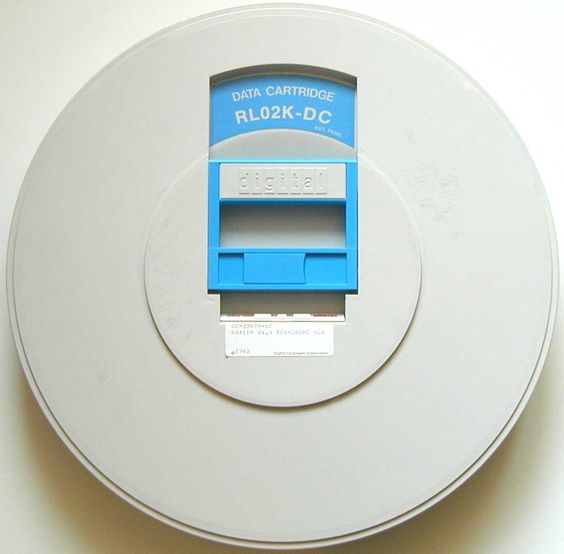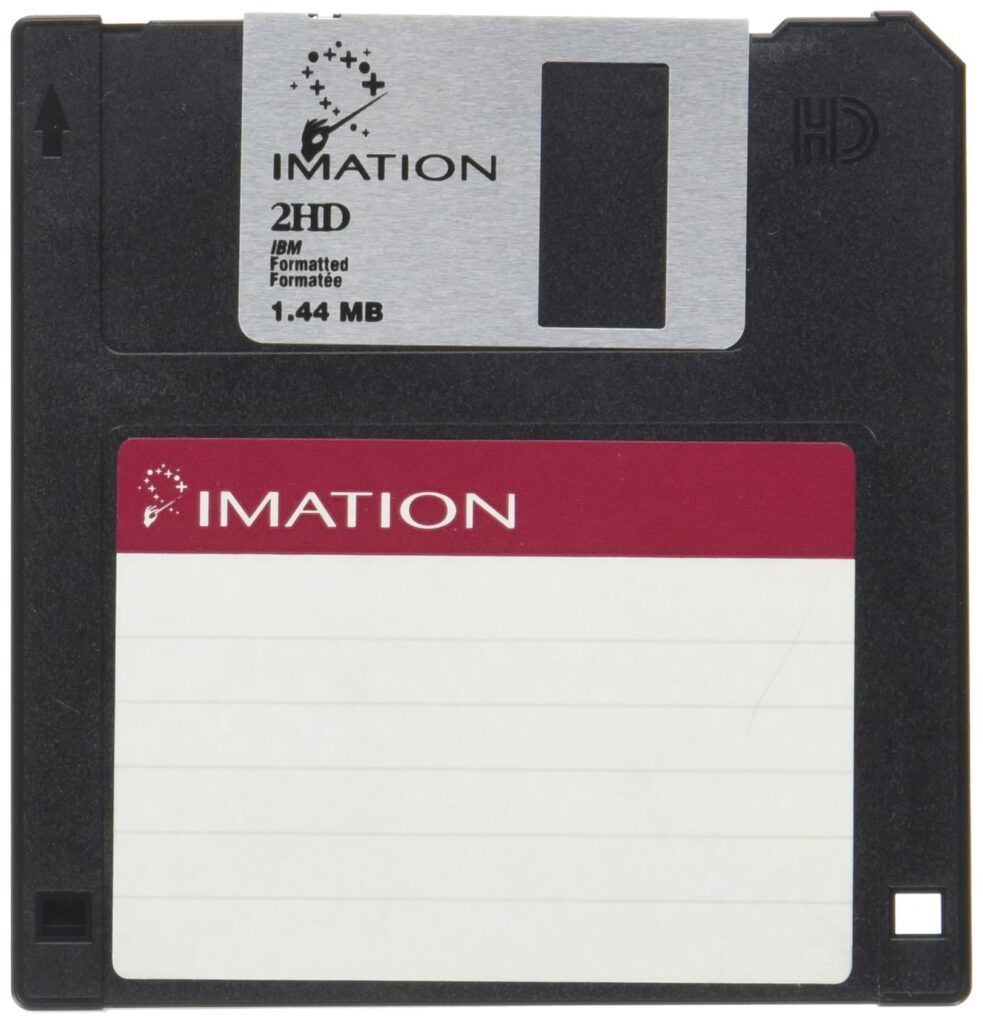Maybe you think you remember the floppy disk. “Hey,” you say, “That wasn’t that long ago.” You’re remembering the 3.5″ hard blue plastic disks that were common as late as 10 years ago. Everyone used them back then.

This is the 8″ floppy disk shown being held by an average adult person. This was one disk, about the size of an iPad. It didn’t have a hard plastic shell so it was a lot easier to damage. It held an amazing 100 kilobytes, which is a ridiculously small fraction of a gigabyte. You would need 7,000 of these to hold ten songs.
When it first became available in 1971, it was the wonder of the age. Programmers in those days used gigantic storage platters that were 2 feet in diameter and 1 foot tall. This was a storage medium you could put in a briefcase and that was impressive.
The term “floppy disk” was first coined to distinguish the storage medium from disk cartridges that looked like this:

This RL02 disk cartridge was about the size of a pizza box. It was encased in a hard plastic shell which was removed using the handle in the center when the cartridge was placed in its reader. The reader itself could be about the size of a washing machine. Altogether, this monstrosity held the equivalent of about ten floppy disks. It was fast and reliable but it was a drag to carry around.
A “floppy disk” was so small partially because it wasn’t rigid. Rather than a plastic case, the magnetic material was simply in an envelope made of black plastic. That envelope was generally put in a tyvek sleeve for transport. Compared to a disk cartridge, it was a miracle of miniaturization.
The floppy disk used the same magnetic technology used by tape readers but combined it with random-access technology like what was used in jukeboxes at the time. A robotic arm could position itself anywhere on the spinning surface of the disk, meaning that it didn’t take a lot of time to find the data you were looking for.
It took about twenty minutes to read all the data from that floppy disk, which wasn’t as fast as other storage technologies of the day but it was easy to take from place to place. You could even bring it on an airplane!
Floppy disks had quite the heyday in the last quarter of the 20th century. The first generation of home PCs used them, at least those PCs that didn’t use cassette tapes for the same purpose. However, by the early 21st century (a phrase which will never not make my back hurt) floppy disks had given way to hard disks, CDs, and flash drive.
Speak of hard disks, people at the time often called this a “hard disk.”

This is a 3.5″ floppy disk, which unlike the larger disks had a hard plastic shell. Because the disks were so small, the harder shell added to portability and durability without sacrificing too much thickness. Some people called it a “hard disk” because it didn’t have that “floppiness” but that was never the correct name for it. “Hard disk” referred at the time to the permanently fixed internal storage device in your computer, not to this removable gem.
8″ floppy disks gave way to the nearly identical-looking 5.25″ disks in the late 1970s and then to the 3.5″ disks. Today floppy disks are gone from our lives, although they still show up as the “save” icon in your word processing program, mostly because no one has figured out a better icon for that yet.
The post OBSOLETE TECHNOLOGY: Floppy Disk appeared first on The Solid Signal Blog.
Continue reading...
Where floppy disks started

This is the 8″ floppy disk shown being held by an average adult person. This was one disk, about the size of an iPad. It didn’t have a hard plastic shell so it was a lot easier to damage. It held an amazing 100 kilobytes, which is a ridiculously small fraction of a gigabyte. You would need 7,000 of these to hold ten songs.
When it first became available in 1971, it was the wonder of the age. Programmers in those days used gigantic storage platters that were 2 feet in diameter and 1 foot tall. This was a storage medium you could put in a briefcase and that was impressive.
Why they called it “floppy”
The term “floppy disk” was first coined to distinguish the storage medium from disk cartridges that looked like this:

This RL02 disk cartridge was about the size of a pizza box. It was encased in a hard plastic shell which was removed using the handle in the center when the cartridge was placed in its reader. The reader itself could be about the size of a washing machine. Altogether, this monstrosity held the equivalent of about ten floppy disks. It was fast and reliable but it was a drag to carry around.
A “floppy disk” was so small partially because it wasn’t rigid. Rather than a plastic case, the magnetic material was simply in an envelope made of black plastic. That envelope was generally put in a tyvek sleeve for transport. Compared to a disk cartridge, it was a miracle of miniaturization.
How floppy disks worked
The floppy disk used the same magnetic technology used by tape readers but combined it with random-access technology like what was used in jukeboxes at the time. A robotic arm could position itself anywhere on the spinning surface of the disk, meaning that it didn’t take a lot of time to find the data you were looking for.
It took about twenty minutes to read all the data from that floppy disk, which wasn’t as fast as other storage technologies of the day but it was easy to take from place to place. You could even bring it on an airplane!
The heyday of floppy disks
Floppy disks had quite the heyday in the last quarter of the 20th century. The first generation of home PCs used them, at least those PCs that didn’t use cassette tapes for the same purpose. However, by the early 21st century (a phrase which will never not make my back hurt) floppy disks had given way to hard disks, CDs, and flash drive.
Speak of hard disks, people at the time often called this a “hard disk.”

This is a 3.5″ floppy disk, which unlike the larger disks had a hard plastic shell. Because the disks were so small, the harder shell added to portability and durability without sacrificing too much thickness. Some people called it a “hard disk” because it didn’t have that “floppiness” but that was never the correct name for it. “Hard disk” referred at the time to the permanently fixed internal storage device in your computer, not to this removable gem.
8″ floppy disks gave way to the nearly identical-looking 5.25″ disks in the late 1970s and then to the 3.5″ disks. Today floppy disks are gone from our lives, although they still show up as the “save” icon in your word processing program, mostly because no one has figured out a better icon for that yet.
The post OBSOLETE TECHNOLOGY: Floppy Disk appeared first on The Solid Signal Blog.
Continue reading...

